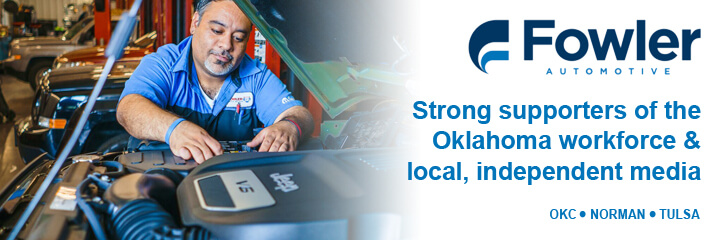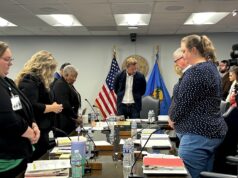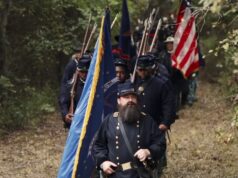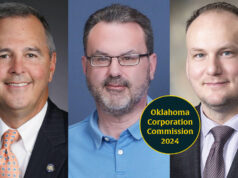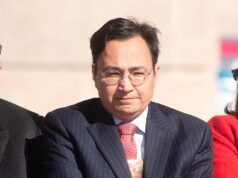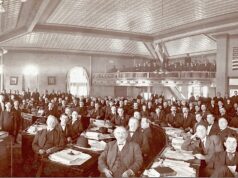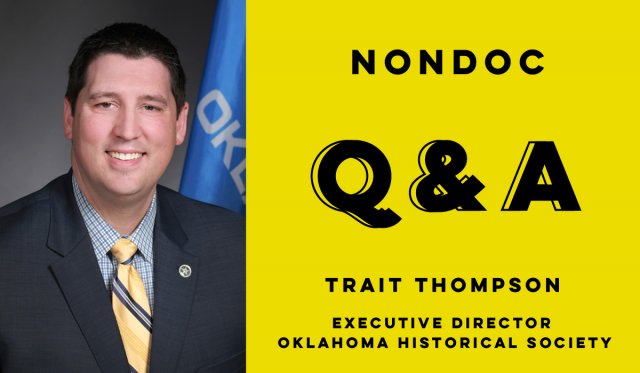
Last spring, Bob Blackburn announced he would be retiring as executive director of the Oklahoma Historical Society. Blackburn, a historian and author, had held the post since 1999, so his departure marked a crucial juncture for the organization.
In November, the Historical Society’s board of directors announced that Trait Thompson had been selected as the new director. Thompson, whose background is in politics and public administration, has spent the past six years overseeing the restoration of the State Capitol, a project that has required a combination of political maneuvering, business management and historical knowledge.
In his first days on the job at the Historical Society, Thompson spoke to NonDoc about his new position, the mission of OHS and his plans for its future. The following interview has been lightly edited for style.
You just started your new job on Jan. 4. How have your first days been, and what projects are you most excited to start?
My first few days at the Oklahoma Historical Society have been incredible. Much of what I have focused on and will focus on in the coming weeks is learning the agency and getting to know our incredible staff members who make it work. My predecessor, the incomparable Dr. Bob Blackburn, will be working through Feb. 1, so I’m going to take every opportunity I can to soak up his knowledge. Additionally, we will be traveling to most of our museums and historical sites across the state over the next three weeks, so I can get a better perspective on their missions, staffing levels, challenges and opportunities.
Regarding projects, I’m excited to continue building momentum for our mission by working with the Legislature on our appropriated budget. Unfortunately, the pandemic has resulted in lost revenue of $1.1 million due to decreased admissions and event cancellations. It is my hope the Legislature can help us restore those losses, so we don’t lose a step in executing our mission.
We are also working to start an endowment fund for collections, named in honor of Dr. Blackburn. We are asking for private donations to allow us the ability to purchase critical items related to Oklahoma history for our collection. In the past, we have missed out on some great artifacts because we have not had the ability to buy them when they were offered for sale.
Another project we are working on is a new history museum in the Oklahoma State Capitol. We were allotted 4,000 square feet of space on the ground floor to tell the story of the building’s construction and restoration project as well as to educate visitors on the branches of government and explain the legislative process. It’s going to be a great tool for educating the public on the political process in Oklahoma.
Finally, we are working diligently to complete the Oklahoma Museum of Popular Culture (OKPOP) in Tulsa. Scheduled for completion in 2022, this museum will be the first of its kind in our region and will showcase the amazing talent Oklahoma has produced in the creative and performance art community.
You’re not a historian by profession, but how did you get interested in history? How has your career led up to your current job?
During my freshman year of high school, I took an honors American history class taught by Dr. Bill Graves. Growing up in a small, central-Texas town, it was not common for a person with a Ph.D. to teach at the high school level. Dr. Graves, or “Doc” as we all called him, was a colorful man with a booming voice that could be heard throughout the corridors of the school. When he taught, he continuously paced around the classroom as he told stories that weren’t mentioned in the pages of our textbook. I was hooked. I started reading more about history on my own, and I worked hard to get an “A” in his class. He didn’t dispense them easily.
In college, I briefly considered majoring in history, but I talked myself out of it because I thought it wouldn’t be a “practical” degree. Nevertheless, I took some history electives and, as a natural offshoot to my love of history, started participating in student government and volunteering for political campaigns. I served as student body president at ORU my senior year.
After graduating from Oral Roberts University in 2000, I worked in telecom for a while and then enrolled in the George H.W. Bush School of Government and Public Service to get my master’s degree in public administration. In 2010, I started a job as policy advisor to President Pro Tempore Brian Bingman in the Oklahoma State Senate. During my four years working for him, I got a crash course in Oklahoma politics and our history. I also had the good fortune to be on the front lines of working to obtain funding for the restoration of the Oklahoma State Capitol.
Once legislation for the restoration project was signed into law, in 2014, I was hired by OMES to manage the project. During the past six years on the $280 million project, through extensive research, I became intimately familiar with the history of the Capitol. I gave hundreds of tours and spoke to civic groups from all over the state, not only to educate them about the project but also to shine a light on the unique and interesting story of how the Capitol came to be and the function it has served for millions of Oklahomans for the past 104 years. I’m now working on a book about the building and the restoration project, which I hope to have completed in 2022.
Finally, I also completed a nomination to get an Oklahoma City building on the National Register of Historic Places. I spent a year researching the history of the building, collecting photographic images and writing the nomination. In 2019, I was successful in getting Oklahoma architect Solomon Layton’s Oklahoma City Public Schools Administration Building, at 400 N. Walnut, listed on the register. It was Layton’s 23rd building to be listed.
What, in your mind, is the most important aspect of the historical society’s work?
The mission of the Oklahoma Historical Society is to collect, preserve and share Oklahoma’s history. Begun in 1893 by the Territorial Press Association, its original mission was to collect newspapers as a way of preserving the still-unfolding history of Oklahoma territory. Today, the OHS operates 23 museums, historical sites and affiliates across the state. It has digitized 5 million newspapers, has over 100,000 artifacts in its collection, has converted 1 million photographs to digital images, has 60 million feet of microfilm, has shepherded the nominations of 1,382 properties to the National Register of Historic Places and has an annual budget of $19 million. We are accredited by the American Alliance of Museums and are an affiliate of the Smithsonian and the National Archives.
Taking all of this into account, the most important work we do is provide an avenue to shine a light on Oklahoma’s most important asset: its people. Through our collections and our historic sites, we are able to highlight the positive and negative aspects of our character, our ambition, our compassion, our determination and our steadfastness. By understanding ourselves better, we can decide the kind of state we want our children and grandchildren to inherit. Our hope is that by fulfilling our mission at OHS, we will inspire the creation of a better Oklahoma in the future.
What plans do you have for the future of the society?
If the pandemic has taught us anything, it’s that we must be prepared to execute our mission and be accessible even when people may not be able to visit us physically. To be clear, the world has been moving in this direction, but this necessity has been accentuated by recent events. One of my first major initiatives will be to enhance the digital footprint of our agency. We will continue our efforts to digitize newspapers, historical documents and photographs, but I want to make finding those items easier for the end user.
Going farther, I will work with our team to develop a comprehensive social media strategy for OHS and all our sites to ensure we are creating informative, engaging content that attracts a wider audience. I want to start creating short YouTube documentaries on important historical subjects and get our podcast going again. I would also like to create virtual tours for our museums and historic sites to expand our reach globally.
You directed the restoration of the Oklahoma State Capitol. What was the biggest challenge in that process?
As you can probably imagine, there were quite a few challenges throughout the restoration process. The first challenge was funding. In 2014, the Legislature allocated $120 million in bond funds for the project. We knew we would need more money but didn’t know how much until we were able to complete our investigation. After our investigative work determined we needed an additional $125 million to properly finish the restoration, it was a challenge to convince the Legislature to allocate more money so quickly after the first bond was passed. However, our interactions with officials at other state capitols convinced us that getting full funding up front was essential to realizing efficiencies in the project that would save money on construction and design costs. The second bond issue passed in 2016 with the exact number of votes needed in the House of Representatives.
We also had the challenge of working in an occupied building. Early in the project, we determined that finding a suitable alternative home for the Legislature would be very difficult and costly, so we decided to phase the project in such a way that we could work around them during the legislative session each year. That decision doubled our timeline for completion, but I believe it was the right one. The first few years of the project were very difficult because we made a lot of noise, generated a lot of dust, and created more than a few strange odors. It was a very difficult environment to work in, and I’m thankful to all the elected officials and staff in the building who were patient with us. The result has been incredible, but it wasn’t easy to get to that point. Thankfully, the project will be completed in about a year, and the memory of those hard years will fade with time.
Is there a piece of Oklahoma history that you wish more people knew about?
Sometimes, I think Oklahomans forget the rich cultural heritage we have as a state. We are a diverse state with a diverse population of actors, writers, musicians, artists, poets and playwrights in all genres of entertainment. We have always been a small state by geographic size and by population, but our cultural output on the world stage has exceeded that size exponentially.
Thankfully, we will soon have a venue to showcase all our incredibly talented people and their works. The Oklahoma Museum of Popular Culture (OKPOP) will be a place to inspire Oklahomans to unleash their creativity and continue the tradition of impacting the rest of the world through song, performance and the written word.

